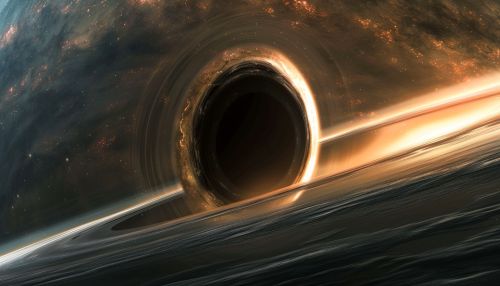Penrose Process
Introduction
The Penrose Process is a theoretical mechanism proposed by physicist Roger Penrose in 1969, which describes a method by which energy can be extracted from a rotating black hole. This process is particularly significant in the context of general relativity and astrophysics, as it provides insights into the dynamics of black holes and the potential for energy extraction from these enigmatic objects.
Theoretical Background
Kerr Black Holes
The Penrose Process is specifically applicable to Kerr black holes, which are a type of rotating black hole described by the Kerr metric. Unlike Schwarzschild black holes, which are non-rotating and spherically symmetric, Kerr black holes possess angular momentum. The Kerr metric is a solution to the Einstein field equations of general relativity, and it describes the geometry of spacetime around a rotating massive object.
Ergosphere
A key feature of Kerr black holes is the presence of the ergosphere, a region located outside the event horizon where the effects of frame-dragging are so strong that no object can remain stationary. Within the ergosphere, all objects are compelled to co-rotate with the black hole due to the dragging of spacetime itself. The boundary of the ergosphere is defined by the static limit, where the time component of the Kerr metric changes sign.


Mechanism of the Penrose Process
Particle Splitting
The Penrose Process involves the splitting of a particle within the ergosphere. A particle entering the ergosphere can split into two fragments: one with negative energy (relative to an observer at infinity) and the other with positive energy. The negative energy particle falls into the black hole, while the positive energy particle escapes to infinity. This results in a net extraction of energy from the black hole.
Energy Extraction
The energy extraction mechanism relies on the conservation of energy and angular momentum. When the negative energy particle is absorbed by the black hole, it effectively reduces the black hole's mass and angular momentum. The escaping positive energy particle carries away more energy than the original particle had, leading to a net gain in energy for an external observer.
Mathematical Formulation
Energy and Angular Momentum Conservation
The mathematical formulation of the Penrose Process involves the conservation laws of energy and angular momentum. Let \( E \) and \( L \) represent the energy and angular momentum of a particle, respectively. For a particle in the ergosphere, these quantities are governed by the equations:
\[ E = -g_{tt} \dot{t} - g_{t\phi} \dot{\phi} \] \[ L = g_{\phi t} \dot{t} + g_{\phi\phi} \dot{\phi} \]
where \( g_{tt} \), \( g_{t\phi} \), and \( g_{\phi\phi} \) are components of the Kerr metric, and \( \dot{t} \) and \( \dot{\phi} \) are the time and angular velocity components of the particle's motion.
Efficiency of the Process
The efficiency of the Penrose Process is determined by the ratio of the energy extracted to the initial energy of the particle. The maximum efficiency is given by:
\[ \eta = 1 - \frac{E_{-}}{E_{+}} \]
where \( E_{-} \) is the energy of the negative energy particle, and \( E_{+} \) is the energy of the escaping positive energy particle. The theoretical maximum efficiency of the Penrose Process is approximately 20.7%.
Astrophysical Implications
Energy Sources in Astrophysics
The Penrose Process has significant implications for understanding high-energy astrophysical phenomena. It provides a potential mechanism for the enormous energy outputs observed in quasars and active galactic nuclei. These objects are believed to harbor supermassive black holes at their centers, and the Penrose Process could contribute to the energy generation in these environments.
Gamma-Ray Bursts
Another area of interest is the role of the Penrose Process in gamma-ray bursts (GRBs). GRBs are among the most energetic events in the universe, and the extraction of rotational energy from a black hole via the Penrose Process could be a contributing factor to their immense power.
Limitations and Challenges
Practical Feasibility
While the Penrose Process is theoretically sound, its practical feasibility remains a topic of debate. The conditions required for particle splitting and energy extraction within the ergosphere are extreme, and replicating these conditions in a controlled environment is currently beyond our technological capabilities.
Competing Mechanisms
There are also competing mechanisms for energy extraction from black holes, such as the Blandford-Znajek process, which involves the extraction of energy via electromagnetic fields. Understanding the relative contributions of these processes in astrophysical settings is an ongoing area of research.
See Also
- Kerr metric
- Frame-dragging
- Ergosphere
- Blandford-Znajek process
- Gamma-ray burst
- Active galactic nucleus
